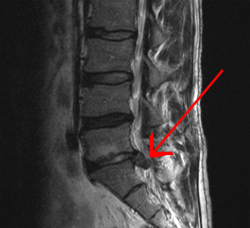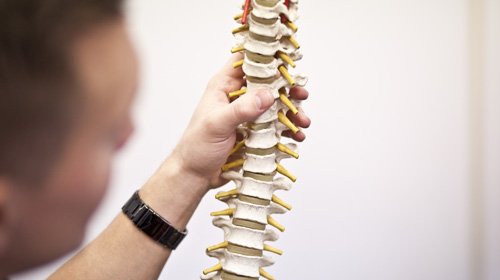|
BOOK NOW |
ASK ABOUT YOUR PAIN |
Home > Blog > Spinal Physio > Ruptured Disc Physiotherapy
Ruptured Disc Physiotherapy

Ruptured spinal discs are the same as herniated/slipped discs, and they're predominantly caused by gradual, age-related wear and tear of the disc (often called disc degeneration).
What happens is that as we grow older, the discs in our spine will start to lose their fluid content, and this causes them to be
- less fluid
- less flexible
- and as a result, more at risk to rupture...even with simple activities and tasks.
In fact, a high number of patients we treat in our physio clinic is due to neck pains and back pains, and a high number is due to spinal disc ruptures. Patients report that their back pain happened when they used their back muscles to push, carry or lift loads (instead of using the proper and safe lifting technique of using their leg muscles).
The most common reason is combination loads to the back ie bending the back AND twisting. Carrying a load whilst doing so increases the risk and severity of spinal disc injuries.
Other ways that causes spinal disc ruptures are:
- falls
- direct blow/trauma/hits to your spine
As we age and our spinal disc becomes less fluid and less flexible, the risk of ruptured spinal disc increases. When the spinal disc ruptures, what happens is that a portion/part of the disc flows out of its normal area, and presses onto nearby structures (usually the spinal nerves first), causing sciatica, and symptoms include:
- numbness
- pain
- weakness
Ruptured Disc Symptoms
Not every patient who has a ruptured or slipped disc has painful symptoms - in fact, sometimes it can have no symptoms at all (this is corroborated with the fact that some patients who have no weakness or numbness...but their MRI can show a massive ruptured disc).
Of course, that' just a minority.
Most patients who have ruptured or slipped disc experience pain, and the most common symptoms are:
- pain
- discomfort
- numbness/pins and needles/tingling
- weakness
- mainly in their backs, buttocks, legs if the ruptured disc is low back; if it's in the neck, the discomfort may be present in shoulders, arms, hands and even fingers. Some patients may experience sciatica, which refers to a pain can travel downwards the arms or the legs, depending on the location of spinal disc rupture.
Ruptured Disc physiotherapy

Generally patients with ruptured, slipped or herniated disc will improve with non-surgical interventions with spinal physiotherapy.
ie surgery isn't always a required for a ruptured or herniated spinal disc. Yes, for very severe cases, immediate surgery can be required with good results, but for most cases (up to 90%) will benefit from back and neck physiotherapy.
Physiotherapy for slipped disc depends on a few factors:
- age
- how active patient is/has been
- severity of symptoms including pain
Our senior spinal physiotherapist will then provide you with unrushed, one-to-one spinal stabilization physiotherapy manual therapy and exercises, which sometimes do not directly target the disc but works indirectly to stabilize, strengthen and help your spine muscles to work together to protect the affected spinal disc.
Other physiotherapy treatment for herniated or ruptured disc includes:
- computer-guided spinal decompression traction to decrease load and spasm on the spine
- gentle spinal mobilization and manipulation techniques
- soft tissue management to improve glide and movement of joints
- gentle but firm massage to release any tight muscles
- ultrasound therapy to accelerate healing of the slipped disc
Our senior spinal physios will also teach and advise you how to exercise safely for your spine and how to prevent future recurrence of back pains and ruptured discs.